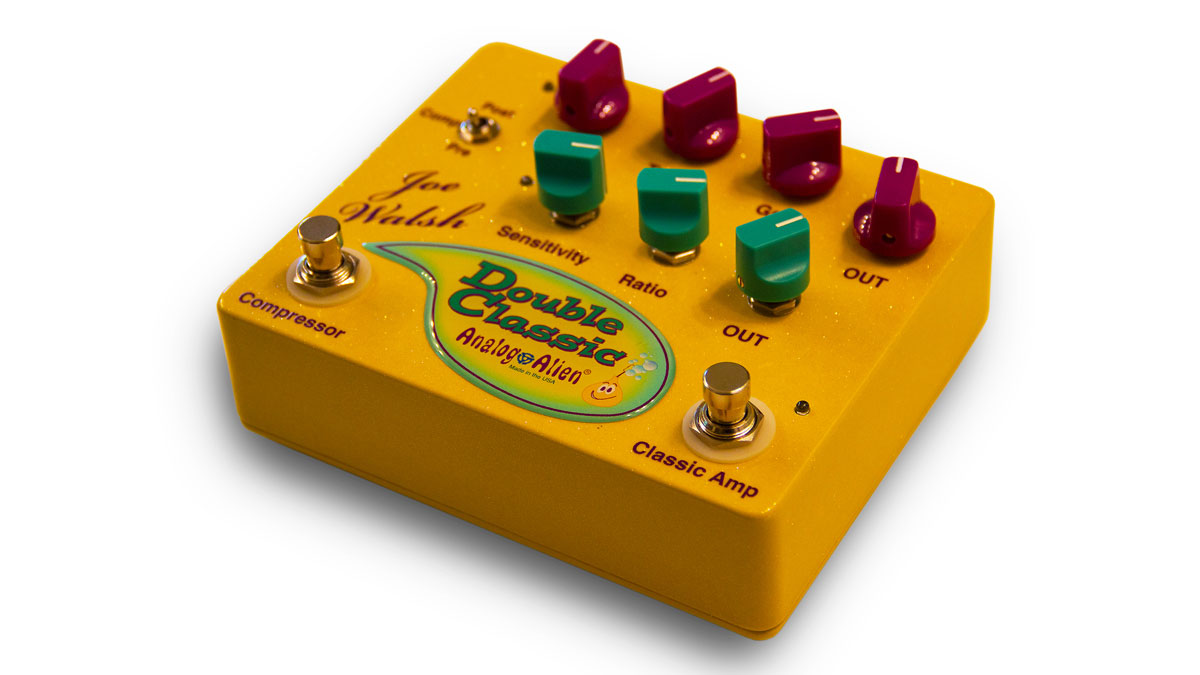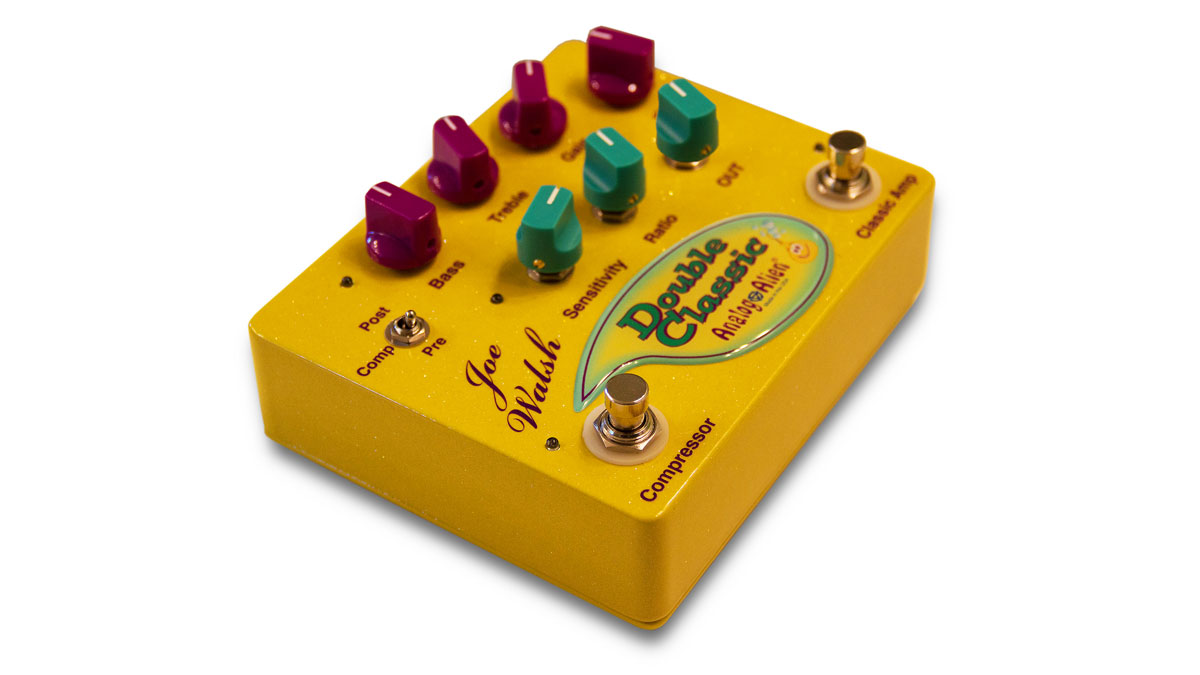Analog Alien unveils the Joe Walsh Double Classic (JWDC)
Eagles man gets Alien stompbox

Analog Alien unveils the Joe Walsh Double Classic (JWDC)

Side 1

Side 2
Boutique effects firm Analog Alien has teamed-up with Eagles legend Joe Walsh for a new compressor and amp sim pedal, the Joe Walsh Double Classic.
The colourful dual effects stomper combines a "natural and musical" compressor with an amp simulator that emulates the "classic tube amps that Joe has used over the years", though the firm hasn't specified which rigs or era its using as the base for that sound.
There's also a useful pre/post switch, which alternates the compressor circuit placement in the signal chain, either before or after the amp sound.
The pedal will be available in the US from 1 October. Check out the full press release below for more details.
Press release
We are honored to collaborate with Joe Walsh to release his first ever signature pedal in his near 50-year career: The Joe Walsh Double Classic. Walsh is the legendary guitarist of the Eagles, Barnstorm, James Gang, The Party Boys, and Ringo Starr & His All-Starr Band.
Inducted into the Rock and Roll Hall of Fame, his playing style has caught much acclaim including praise from rock music giants Led Zeppelin's Jimmy Page, Cream's Eric Clapton and The Who's Pete Townshend. The Double Classic is designed mimic the authentic Joe Walsh style and sound.
The Joe Walsh Double Classic, or JWDC for short, is a dual effects pedal that we designed specifically for Joe Walsh. This unique, one of a kind pedal, combines two essential circuits (Compressor & Classic Amp), which Joe uses in both live performances and studio recordings.
Want all the hottest music and gear news, reviews, deals, features and more, direct to your inbox? Sign up here.
COMPRESSOR
The Compressor in the JWDC allows you to control the dynamic range of your instrument. Unlike most stomp box compressors, the compressor in the JWDC has a very natural and musical sound - much like professional rack mounted compressors found in professional studios.
Sensitivity - This control is similar to a threshold control that is found on professional studio compressors. It allows you to make adjustments to the signal level at the input stage of the unit. This control comes in very handy if you are using a bass or a guitar with active pickups. Active pickups tend to have a hotter output than passive pickups. By adjusting the sensitivity properly the output level of your instrument can be controlled, so as not to distort the input of the compressor. The opposite is true if the bass or guitar has passive or low output pickups. Raising the sensitivity control increases the input level, providing a stronger input signal which the compressor needs in order to work properly.
Ratio - This knob allows you to set the compression ratio. The range is adjustable from 2:1 to 10:1. The more you turn this knob up (clockwise) the higher the compression ratio. There is also a soft knee feature built into the circuit. This means that the ratio will start low and will then increase in direct proportion to the amount that the signal exceeds the threshold. Everything from mild to fairly heavy compression settings are possible. The compressor is a very flexible circuit that has both smooth and natural sounds. You will be able to control the dynamic range of your instrument while simutaneously preserve it's tonal character.
Output - This knob controls the level of the output signal from the compressor to the next effect in your signal chain.
CLASSIC AMP
The Classic Amp was designed to simulate the classic tube amps that Joe has used over the years. The sound of these vintage amps is legendary and can be heard on countless recordings that Joe has made through out his career. The controls on a classic tube amp were designed to be simple and straight-forward and the same is true for the Classic Amp.
Bass - This control allows you to cut or boost the low frequencies of your bass. The EQ curve is very smooth and versatile. You will be able to dial in the right amount of low end to give your bass punch and power while still retaining low end clarity.
Treble - The treble knob allows you to adjust the mid and high range frequency spectrum of the bass. You can dial in the right amount of mids and highs without making your bass sound to brittle or harsh.
Gain - The gain control is very versatile. At lower settings (counter-clockwise) there is very little or no gain at all introduced to the signal. At this setting your bass will sound warm and full with no distortion. Keeping the gain control in this position will really allow you to experiment with the EQ settings. You can make some fine adjustments to your sound by simply experimenting with the bass and treble controls. Turning the gain control up (clockwise) introduces distortion. The distortion that the Classic Amp produces is not over the top - like that of a fuzz box. The sound breaks up naturally while at the same time retaining much of it's clarity. Turning the gain up (clockwise) will also give your bass more drive and attitude. Experimentation is the key to unlocking the potential of the Classic Amp and the JWDC in general, so we encourage you to experiment with the pedal often.
Output - This knob controls the level of the output signal from the Classic Amp to the next effect in your signal chain.
PRE/POST SWITCH
The Pre/Post switch allows you to place the compressor before or after the Classic Amp in the signal chain. With the switch in the "Pre" position (down), the compressor is placed before the Classic Amp. With the switch in the "Post" (up) position the compressor is placed after the Classic Amp in the signal chain.
Total Guitar is Europe's best-selling guitar magazine.
Every month we feature interviews with the biggest names and hottest new acts in guitar land, plus Guest Lessons from the stars.
Finally, our Rocked & Rated section is the place to go for reviews, round-ups and help setting up your guitars and gear.
Subscribe: http://bit.ly/totalguitar


